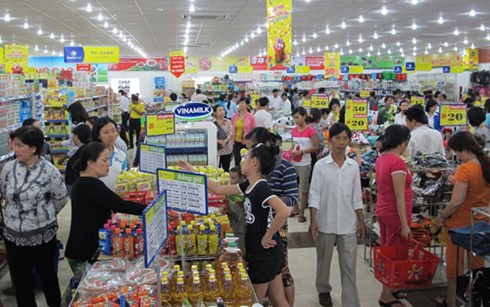Local companies flee urban areas to escape competition
 |
The rate of expansion of FMCG sales in the country’s six main population centres jumped 3.6% on-year for the first quarter of 2016, according to a recently released survey conducted by market research firm Nielsen.
This compared to 5.7% on-year growth for the fourth quarter of 2015.
Beverages, milk products and food were the three biggest sellers for the quarter accounting for 39%, 16% and 15% of total sales for the segment, respectively.
They were trailed by tobacco products (13%), personal care items (8%), household products (6%) and baby products (4%).
Market challenges
The easing of FMCG sales is consistent with the general deceleration of the Vietnam economy whose GDP has slowed to 5.52% on-year growth in the first half of 2016, down from 6.32% for the corresponding six-month period a year earlier.
Consumers in the six major metropolitan areas of Vietnam are increasingly demanding and expecting better choices, according to Nguyen Anh Dung, director of retail measurement services at Nielsen Vietnam.
They are specifically looking for innovative new products, which represents an advantage for newcomers to the market.
According to one recent product innovation study, Vietnamese consumers try more new products than other Southeast Asian consumers, with 88% of Vietnamese buyers reporting they bought a new item during their last shopping trip, compared to a 69% regional average.
However, as trade barriers are lowered as a result of the ASEAN Economic Community, Vietnamese FMCG manufacturers are preparing and drawing up strategies to face greater regional competition.
Potential remains strong
Medium-term potential in the market appears strong, according to a report issued by the Ministry of Industry and Trade early this year. Fuelled by growing incomes and a young consumer base, FMCG spending is expected to climb modestly to US$173 billion by 2020.
Consumer confidence remains relatively strong (though slightly down) heading into the second half of 2016, according to an August Nielsen survey, with the index at 107 points, two below the first quarter’s peak.
The vast majority of manufacturing companies in Vietnam also have a positive outlook for the second half, a General Statistics Office survey reported, with more than 90% of respondents expecting production to either increase (55%) or remain stable (35.4%) in the second half of the year.
Market prospects
The potential consumer market is significant, and the penetration rate for many FMCGs has yet to be maximized, according to Mai Kieu Lien, CEO of dairy industry leader Vinamilk.
However, purchasing power in Vietnam is also one of the lowest in the Southeast Asian region, she told the Oxford business Group recently, so a localized strategy sensitive to pricing has to carefully be put in place.
A number of leading Vietnamese FMCG producers are looking at the country’s neighbours for growth.
Kajiwara Junichi, CEO of food manufacturer Acecook Vietnam, recently told reporters his company is focusing on Laos, Myanmar and Cambodia as good markets to enter.
Another area of potential growth is the rural regions of Vietnam, home to roughly two-thirds of the population and almost entirely ignored by foreign companies entering the Vietnam market.
According to a report by market survey company Kantar WorldPanel, household income in rural areas in Vietnam is rising faster than in the urban centres in terms of percentage rate of growth.
Though, obviously this survey could be misleading.
The rate of increase is simply magnified because the starting wage base is extremely low.
The wage base in absolute dollars in the rural areas of Vietnam is small, which accounts for the lack of interest of foreign companies in pursuing these markets.
However, local Vietnamese brands are aggressively seeking market share in the rural areas outside of the six major metropolitan areas of the country as they search for refuge from the onslaught of foreign competition.
What the stars mean:
★ Poor ★ ★ Promising ★★★ Good ★★★★ Very good ★★★★★ Exceptional
Latest News
More News
- Businesses ramp up production as year-end orders surge (December 30, 2025 | 10:05)
- Vietjet chairwoman awarded Labour Hero title (December 29, 2025 | 13:06)
- How to unlock ESG value through green innovation (December 29, 2025 | 10:03)
- AI reshapes media and advertising industry (December 29, 2025 | 08:33)
- FPT and GELEX sign deal to develop blockchain tech for global markets (December 29, 2025 | 08:29)
- Vietnam’s GDP forecast to grow by 9 per cent in 2026 (December 29, 2025 | 08:29)
- Women entrepreneurs are key to Vietnam’s economic growth (December 29, 2025 | 08:00)
- Vietnam's top 500 value-creating enterprises announced (December 27, 2025 | 08:00)
- The PAN Group shaping a better future with ESG strategy (December 26, 2025 | 09:00)
- Masan Consumer officially lists on HSX, marking the next phase of value creation (December 25, 2025 | 13:20)

















 Mobile Version
Mobile Version